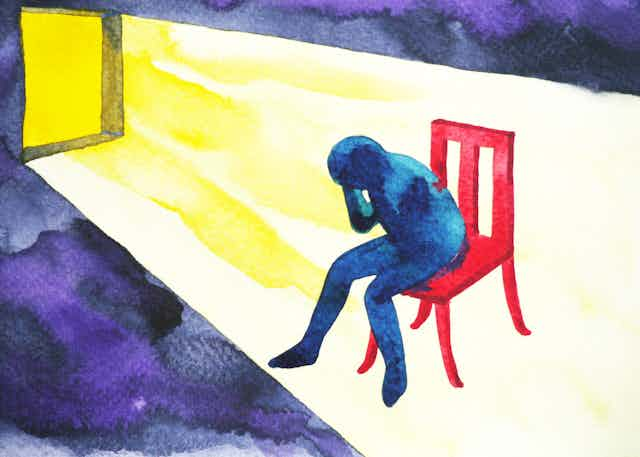Suicide is a tragic event. Unfortunately, every 40 seconds, a person dies by suicide. Beyond the premature loss of an individual’s life, more that 100 people may be affected by each suicide, including family, friends and community members.
People considering their own death have often gone through long periods of intense suffering and internal struggles. They may have endured mental illness and experienced a range of adverse life events. Helping people suffering from a mental disorder and/or going through a difficult time is therefore of the utmost importance to preventing suicide.
However, evidence from research conducted in the past two decades has highlighted that suicide is not only the result of such contributing factors around the time of death. Instead, vulnerability to suicide may build up throughout the course of life. It may start with events occurring very early in life, in the perinatal period and infancy, that have long-lasting influences on suicide in adulthood.
The developmental origins of health and diseases
In the 1990s, British epidemiologist David Barker noticed that children born with low birth weight (less than 2.5 kilograms) or preterm (before 37 weeks) were more likely to develop chronic conditions such as cardiovascular or metabolic diseases as adults. These observations served as the foundation of the developmental origins of health and diseases (or DOHaD) hypothesis.
The DOHaD hypothesis suggests that exposure to environmental influences during the critical period of fetal development could have significant consequences on an individual’s short- and long-term health. This knowledge promoted early-life interventions such as prenatal and infant nutrition to improve long-term outcomes. It also supported guidelines to promote quality care before, between and during pregnancies.
As such, the DOHaD hypothesis has increased scientific interest in understanding how early-life events influence the risk of other health problems, including suicide.
Early-life origins of suicide

As researchers with the LIFESPAN research project, our goal is to better understand whether early-life factors influence the risk of suicide later in life, and how. If early life factors are associated with suicide, suicide prevention strategies need to be implemented early in life.
Within the LIFESPAN project, we recently conducted a meta-analysis looking at 42 articles from 21 longitudinal cohort studies from Europe, North America, South America and Asia. It examined associations of 14 early-life factors in the prenatal and perinatal periods — including low birth weight, obstetric complications, impoverished socio-economic conditions of the family at childbirth and young parental age — with later suicide.
Out of the 14 factors investigated, seven were associated with suicide in adulthood, providing support for the DOHaD hypothesis. The strongest early-life influences on later suicide were parental characteristics such as low parental education, low family socio-economic conditions and young maternal age, as well as restricted fetal growth, including low birth weight.
For example, researchers found that children born with a lower birth weight or who were premature were more likely to die by suicide than children born with normal birth weight. They also found that children of teenage parents were more likely to die by suicide than children of older parents, and that children born to parents with lower levels of education were more likely to die by suicide than children born to parents with higher levels of education.
It is important to note that these are epidemiological findings that should not be directly applied to the single individual, but rather they should be applied to the population. We cannot consider a prematurely born baby as being at risk of suicide, but in a given population, babies born prematurely are, on average, at higher risk of dying by suicide than children born at term.
How early-life risk factors increase suicide risk

An important followup question is to understand why factors occurring very early in life may influence behaviour happening decades later. A first theory implicates social mechanisms. Socio-economic factors (such as poverty or lower education levels) are key determinants of health and tend to be transmitted from one generation to another.
Children born to a family with low financial resources may have restricted access to quality education, health care and life opportunities. This may increase their chances of being confronted with financial and social problems in adulthood, which may in turn increase suicide risk. In other words, social and economic problems that increase suicide risk in adulthood may be, in part, the continuation of the socioeconomic conditions of the family into which a child was born.
This is also true for non-monetary indicators of socio-economic position, such as parental education. Parents who are young and less educated may not have the material and emotional resources to provide their children with the best start in life. Providing resources to young parents from low socio-economic conditions may therefore be an opportunity to improve their child’s health in adulthood, and consequently decreasing suicide risk.

A second theory implicates brain development. The DOHaD hypothesis states that when the fetus is exposed to adversity, it reacts with adaptations to survive a harsh environment in utero. These adaptations may result in impairments in brain development, which are in turn associated with decreased cognitive skills that may further reduce a person’s capacity to deal with stressful events later in life. The capacity to cope with life stress, also known as resilience, is a key protective factor for suicide and mental health problems in general.
Reducing risk factors that may determine low birth weight or fetal suffering, such as poor nutrition, infections, exposure to chemicals or hormonal perturbations, is important for the health of the offspring. However, interventions to boost resilience among children who have experienced adversity during the fetal period may also be a promising avenue for preventing later problems, including suicide.
Suicide prevention from an early-life perspective
Early prevention is universally recognized as a leading way to reduce health problems while minimizing societal costs. Early prevention often means removing or reducing risk factors in a population before a health problem manifests.
In this perspective, research on the early-life origins of suicide invites us to integrate interventions at the individual level with prevention at the population level. It supports the need to think about suicide prevention as a long-term, rather than uniquely a short-term, endeavour with the goal of reducing vulnerability to suicide during the life course.
Public health policy providing the best environment for children to grow up may have the potential to build resilience and reduce the long-term vulnerability to suicide.
If you or someone you know is thinking about suicide, call 911 for emergency services. For support, call Canada Suicide Prevention Service at 1-866-277-3553 (from Québec) or 1-833-456-4566 (other provinces), or send a text to 45645. Visit Crisis Services Canada for more resources.

